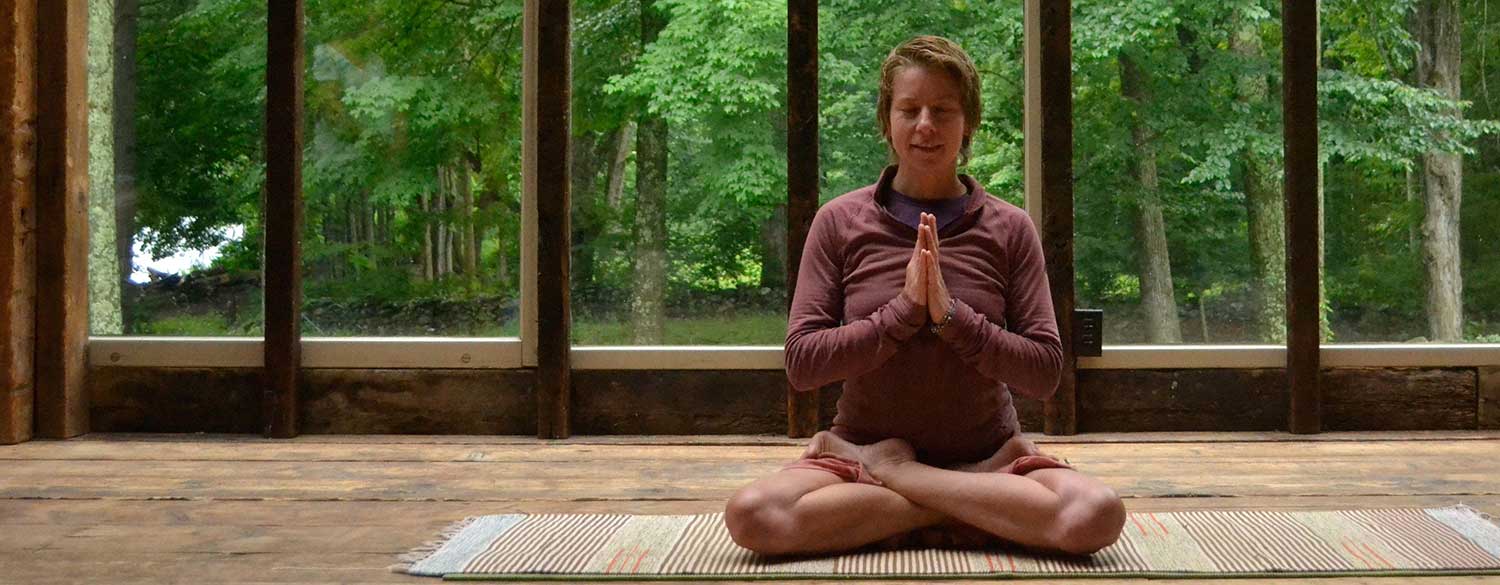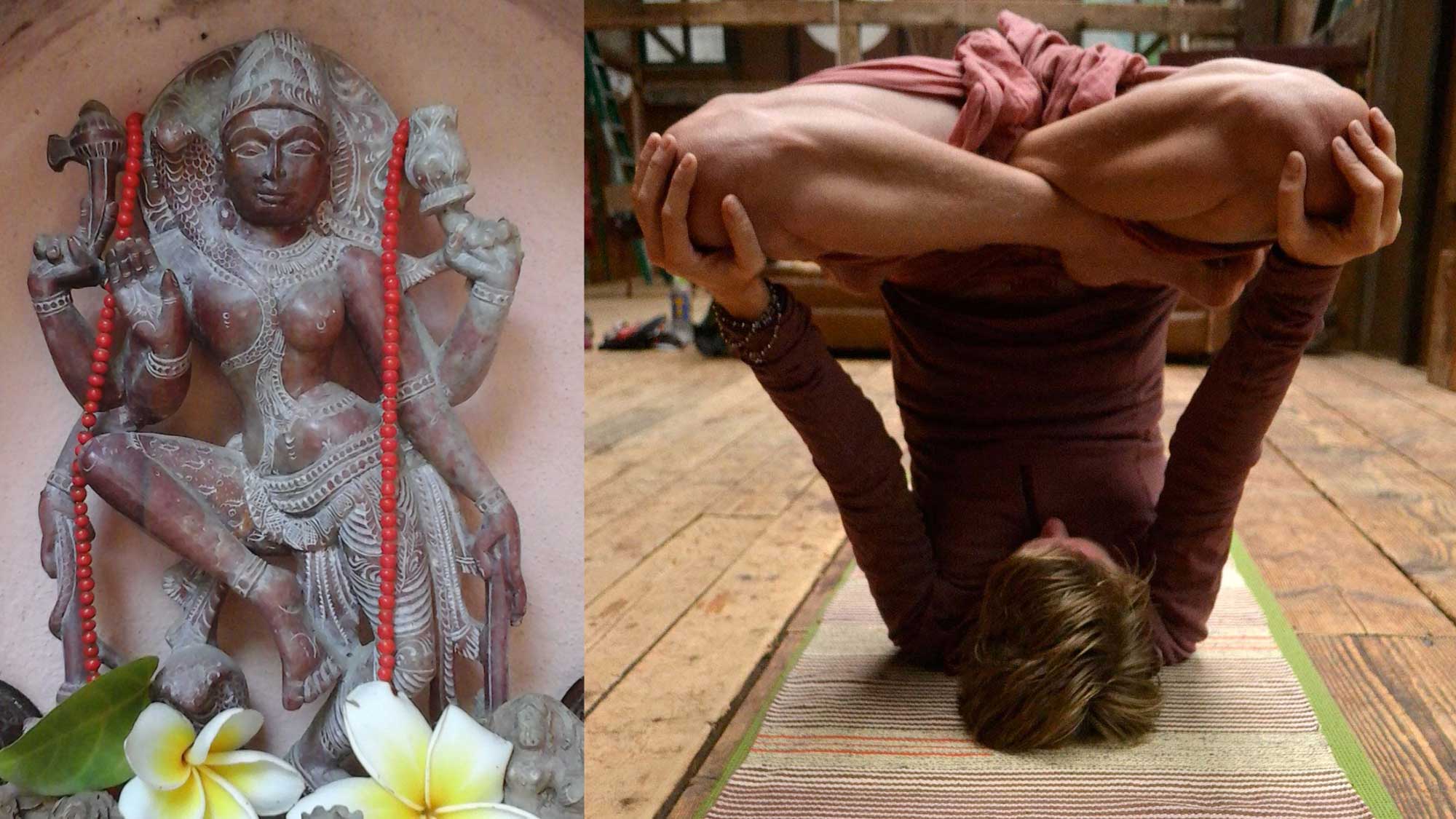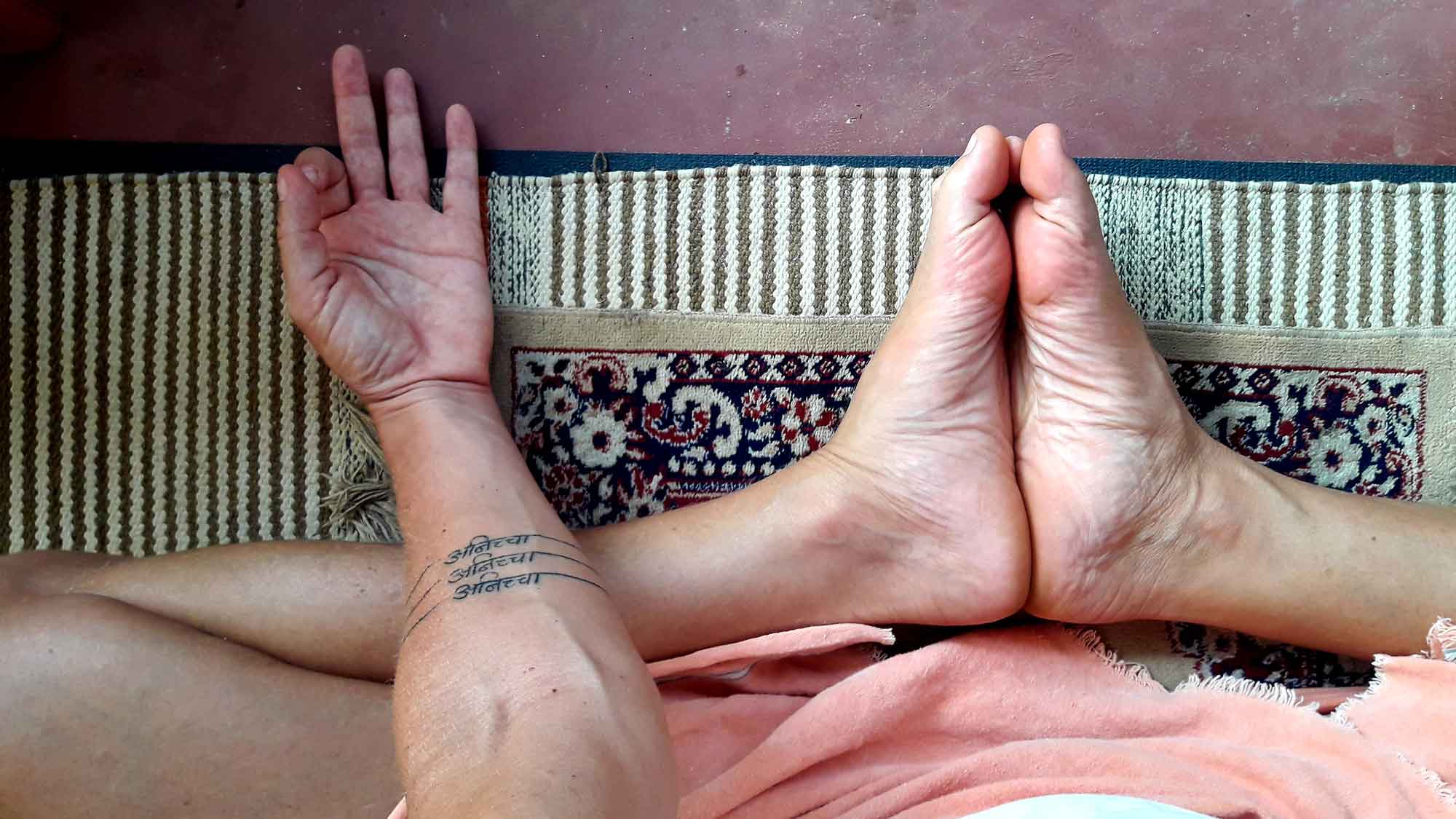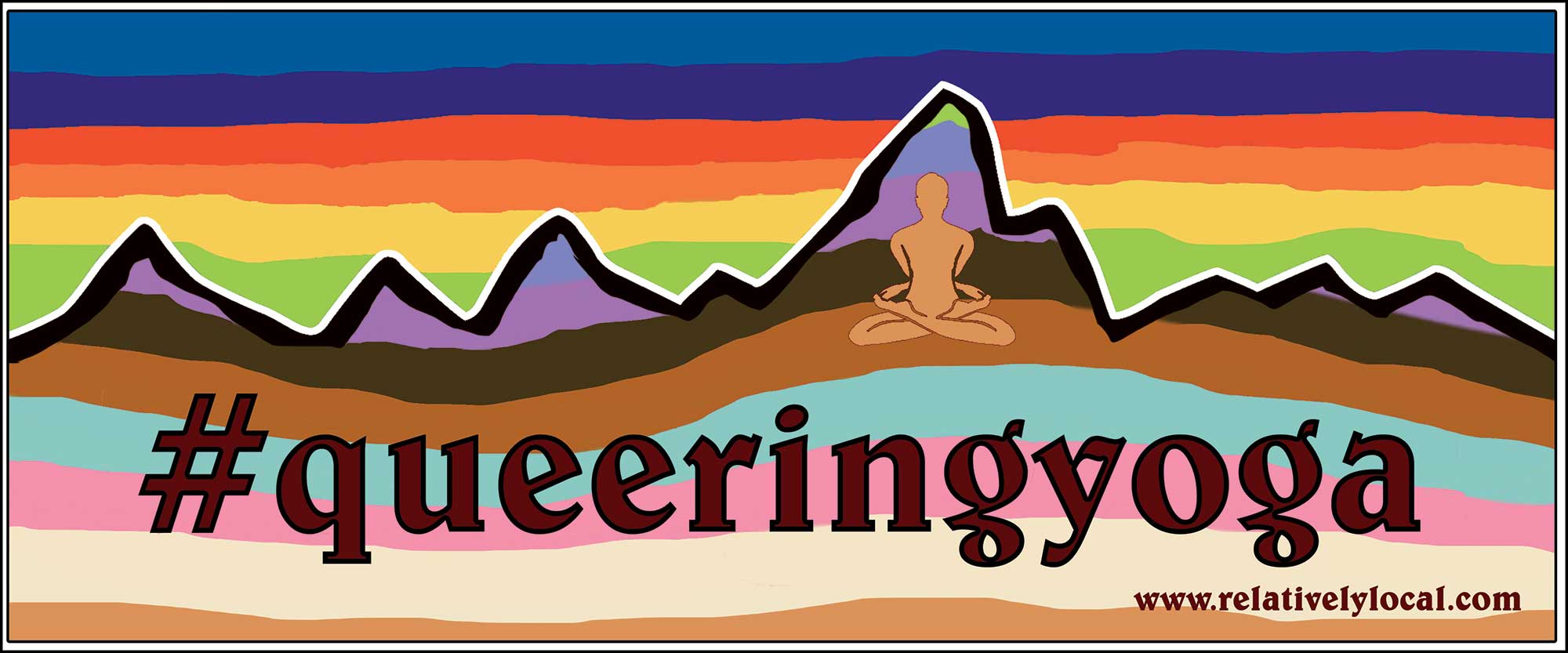Queering Yoga beyond safer spaces & preferred pronouns…
Nicole Jaquis is a Non-Binary Yoga Teacher in India, queering yoga beyond safer spaces & preferred pronouns, with an Ardhanarishwar inspired sadhana, practicing and teaching traditional hatha yoga to balance sun and moon energies within our container bodies.

I remembering googling “queering yoga”
In September 2016 when I returned to the States after nearly seven years living in rural North India, it was beyond culture shock! I was of course curious and wide eyed about so many things in the country and culture I had left behind. My first full day back in Brooklyn, my friends took me to the “Gay Beach” at Riis Beach. What?!? Best culture shock ever! I had been mostly living in the closet in India. Ashram and sadhu lifestyles devoid of dating, deemed my own identifying as queer, unnecessary.
I remembering coming back that evening and googling “queering yoga”. At the top of the Google search I found a documentary film Directed by Ewan Duarte, with the same name (at that time in the middle of production). From there I began to check out some of the teachers featured in the film. It was an exciting rabbit hole, which led me to discovering some yoga studios offering “queer and trans yoga” classes.
Queering Yoga – Dir. Ewan Duarte – (Trailer)
Queering Yoga tells the story of 6 Queer/Trans/QTPOC yoga teachers and their personal stories of healing, transformation and yoga journey.
Themes explored include: What is the intersection of Queer, Trans, and QTPOC identities and yoga? What does empowered and embodied visibility look like for the Queer, Trans, and QTPOC communities? What does it mean to decolonize one’s yoga practice and why is this important? Queering Yoga embraces an intersectional lens to explore identity, personal and community transformation, spirituality and also positions Queer/Trans/QTPOC yoga teachers as important voices and leaders in current day yoga conversations and spaces committed to ending racism, homophobia, transphobia, and embracing more inclusivity. This film has been created with Queer/Trans/QTPOC filmmakers and allies, along with Queer/Trans/QTPOC yoga teachers–a film about our community and by the community!
Yoga studios which offered “queer and trans yoga” classes. Wow!
That beach experience reminded me how eager I was to reconnect with a queer community (after 7 years without one in India). I began seeking out and attending queer and trans yoga classes. It felt so good to be surrounded by people just being themselves, not at all caught up in how the spiritual industrial complex tries to convince us to look. For the first time I didn’t feel weird wearing my lungi in an American commercial yoga studio. This was not a room full of straight passing white women in skin tight “yoga pants”.
Each class started somewhat the same: the instructor and participants introduced themselves, including their pronouns.
This was new to me. Pronouns were not “a thing” among the sadhu circles and ashrams I had been living. Frankly most people in the Akhara scene spoke Hindi using masculine grammatical rules, which influenced my own style of speaking. While pronouns are neutral, verb tenses are gendered in Hindi. And I most often speak as if confused, whether the gendered verb tense applies to the doer or the object of the doing. Compounded with two decades of socializing among masculine styles of speaking, my Hindi grammar became masculine leaning as well. And no one seems to care about that, much less correct me.
Furthermore sadhu clothes are also quite gender neutral; men and women’s styles of dress are not so differentiated. After enduring the typical struggle of negotiating clothing options with my mom as a tomboy child, the idea of gender neutral clothes was a natural appeal to me. However, being mis-gendered, while happening often in India, was something that never bothers me. Rather it makes me giggle as if I have this secret inside, that may not have corresponded with how others perceived me (something I cannot control). And although I had already been identifying as queer and becoming more and more comfortable identifying as non-binary, pronouns were something I hadn’t considered yet. I still don’t worry about preferring any particular pronoun for myself.
Safer spaces do matter.
My first 500 traditional hatha yoga hour teacher training was led by a male teacher (a few years younger than me), who while having a foreign born mother, was raised in conservative Haridwar. Despite traveling abroad to teach each monsoon (since 2011 or so) and considering himself quite modern, he still expressed (borderline toxic) hetero-normative beliefs about men’s and women’s so called nature.
There was one other gay guy in my teacher training batch, who was also enduring homophobic abuse by a fellow student. We still talk about how relieved we were to have come out to each other early on in the three month course. How important it was to have each other to vent to, regarding some of the F*d up shit our teacher would talk about: “men are like this; women are like this” type shit that was completely unrelatable to both of us.
So while returning to NYC and participating in queer and trans yoga classes was such a relief, however queer affirming the space was, there was still something missing in the dialog.
No one mentioned the fact that we are not this body. No one mentioned our atma (soul) has no gender, that we are merely energy covered in a gendered body. No one mentioned Swara Yoga as described in the tantric Sanskrit text शिवस्वरोदय Śivasvarodaya. There were no guided practices to open our सुषुम्ना suṣumnā नाड़ी nāḍī by balancing the energies that travel through the इड़ा iḍā and पिंगला pingalā नाड़ी nāḍī(s). No one mentioned the wholeness we arrive at, from balancing the two hemispheres of our brain, through Swara Yoga informed pranayam. Much less did anyone mention Ardhanarishwar, the half man – half woman deity I consider to be an obvious इष्ट देव isth dev (favorite deity) for the spiritual members of LGBTQIA community.
I left each class wanting to share about all the queer affirming lessons Sanatan Dharma, sadhana and yoga philosophy taught me. While any attempt to engage people, left me feeling like I was speaking a foreign language. And I was.

अर्धनारीश्वर Ardhanārīśwar, Svara Yoga and Why Traditional Hatha Yoga is #queerAF…
The Sanskrit name for the divine form of shiv/shakti अर्धनारीश्वर Ardhanārīśvar (more often written Ardhanarishwar), when broken apart: अर्ध ardha means half, नारी narī means woman, and ईश्वर īśvar means god.
While a surface level reading about Ardhanarishwar in the Shiv Mahapuran from its more common commentaries, may perpetuate the cis-hetero-normative-patriarchal idea that men and women are only complete with the other as their partner, a deeper understanding of सांख्य Sāṅkhya Yoga Philosophy challenges such limited thinking.
In Sāṃkhya philosophy, puruṣa signifies the observer, the ‘witness’. While prakṛti includes all the cognitive, moral, psychological, emotional, sensorial and physical aspects of reality. It is often mistranslated as ‘matter’ or ‘nature’ – in non-Sāṃkhyan usage it does mean ‘essential nature’ – but that distracts from the heavy Sāṃkhyan stress on prakṛti’s cognitive, mental, psychological and sensorial activities. Moreover, subtle and gross matter are its most derivative byproducts, not its core. Only prakṛti acts.
Puruṣa is considered as the conscious principle, a passive enjoyer (bhokta) and the prakṛti is the enjoyed (bhogya). Sāmkhya philosophy teaches that the puruṣa (consciousness) cannot be regarded as the source of inanimate world, because an intelligent principle cannot transform itself into the unconscious world. It is a pluralistic spiritualism, atheistic realism and uncompromising dualism.
My own hatha yoga / swara yoga practice and discovering Ardhanarishwar has supported my owning my queerness / being non-binary…
हठ haṭha = ह ha (lunar energy) + ठ ṭha (solar energy), thus traditional haṭha yoga is the practice of merging the lunar and solar energy in ourselves. But what does that mean and how is this queer / non-binary?
When I discovered the Tantric Sanskrit text: शिवस्वरोदय śivsvarodaya (शिव śiva + स्वर svara + उदय udaya), everything began to make sense regarding my own feeling of not being specifically female. Originally oral tradition later perhaps written sometime between 500.BC to 300. AD, the Śivsvarodaya, like all the Tantras, is a dialog between Śiva and Parvati. Typically the Tantras begin with Parvati asking a question. In the Śivsvarodaya Śiva explains to Parvati the different types of breath / prāṇic rhythms, to answer her question on how to achieve perfection.
स्वर svara = the sound of one’s own breath
उदय udaya = waking / rising
Svara Yoga is a Hatha yoga practice used to reach the state of union, via one’s breath – not to be confused with prāṇayama. Swara Yoga focuses on the movement of prāṇa within the body and its relationship to the mind, prāṇa’s various manifestations in the body and its effects on each organ, in accordance to which nostril (and thus nāḍi) is active.
Svara Yoga is a practice of awareness, manipulation and control of the breath (through which nostril) in order to best participate in particular situations / activities in life.
Within 24 hours our breathing naturally alternates (between left and right nostrils, ida and pingala nāḍis) every hour or hour and 20 mins, stimulating different qualities of energy and thus affecting our nervous system.
What are नाड़ी nāḍis?
There are 72,000 nāḍis mentioned in Gorakśa Samhita and Haṭha Yoga Pradīpika, 300,000 mentioned in Prapañcasara Tantra, 350,000 mentioned in Śiva Samhita and 10 mentioned in Śivasvarodaya. I will discuss three below.
इड़ा iḍā नाड़ीnāḍī emerges from the left of mūladhāra chakra and crossing over each chakra, s-curves its way through the left nostril ending at the ajña chakra. It is the nāḍi that controls the parasympathetic nervous system, entire left side of the body and right hemisphere of the brain.
पिंगला pingalā नाड़ी nāḍī emerges from the right of mūladhāra chakra and crossing over each chakra, s-curves its way through the right nostril ending at ajña chakra. It is the nāḍi that controls the sympathetic nervous system, entire right side of the body and left hemisphere of the brain.
सुषुम्ना suṣumnā नाड़ी nāḍī emerges from mūladhāra up the center of the spine to Sahasrara chakra, indicating balance when the whole brain (both left and right hemispheres) are active. It is the nāḍi that controls the cerebrospinal system, and when open – when breathing is happening through both left and right nostrils simultaneously – actual meditation can happen.
Queer Affirming Lessons Sanatan Dharma, Sadhana and Traditional Hatha Yoga Philosophy Taught me:
Queer Affirming Lessons #sanatandharma #sadhana and #yogaphilosophy taught me:
* I’m not this body. And it is ok to want to change this body.
* I am a witnessing #atma (#soul #spirit #prana #energy) inside this container body.
* My atma has no gender.
* I am not a boy or a girl, neither man nor woman.
* Gender expression is performative.
* My performance is not to make you comfortable around me.
* Gender norms / gender binary are colonial bullshit.
* I can allow myself to be both vulnerable and strong.
* I may cultivate both (so called) #masculine #feminine energies / qualities.
* I prefer to call these energies: sun / moon energies.
* The cultivation of these (so called) Masculine Feminine (solar / lunar) energies / qualities, in equal proportion makes me feel #whole.
* This is done through swara yoga, the sadhana of balancing the इडा, iḍā and पिङ्गल, piṅgala नाडी, nāḍīs – that which opens the सुषुम्णा, suṣumṇā nāḍī and thus balances both left and right hemispheres of my brain.
* Toxic #masculinity or toxic #femininity is an expression of an unbalanced brain.
* Your gender expression is not my lila.
* A lungi is a gender neutral clothing option.
* #ardhanarishwar (as an expression of both shiva shakti) is my #ishtadevata
Other Posts about Queering Yoga and Why Traditional Hatha Yoga is QueerAF
View this post on InstagramA post shared by निकोल relativelyLocal 🏳️🌈🇮🇳🇺🇸 (@relativelylocal) on


